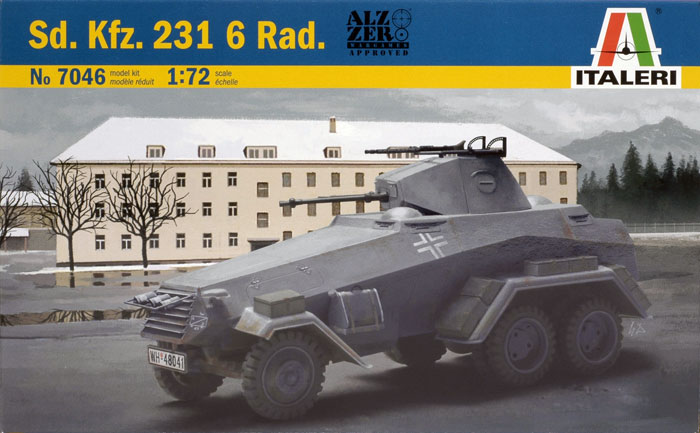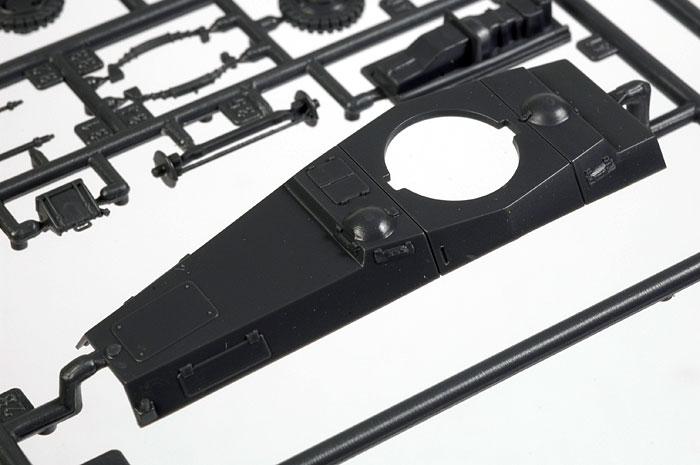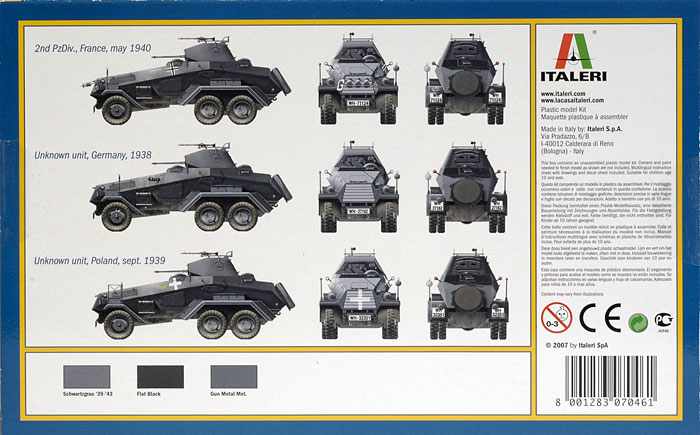|
|
|
|
| Home > Reviews > Small Scale > Italeri 1/72 Sd.Kfz. 231 6 Rad (7046) |
Sd.Kfz. 231 6 Rad
Italeri 1/72 Scale
Reviewed by Cookie Sewell

Summary
| Stock Number and Description | Italeri 1/72 scale Kit No. 7046; Sd. Kfz. 231 6 Rad |
| Scale: | 1/72 |
| Media and Contents: | 59 parts in dark grey styrene |
| Price: | US$12.50 |
| Review Type: | First Look |
| Advantages: | Nice. cleanly executed kit of this different subject |
| Disadvantages: | "One way" to build it; odd choice of items to fully detail and just simplify |
| Recommendation: | Recommended for all early war German armor fans as well as wheeled armor lovers |
FirstLook
During World War I almost all armored cars shared two features: they
only had two axles and they were not really suited for cross country
operations. Between the wars, heavier armored cars were introduced,
and even on roads that required using at least three axles. The US,
Soviet Union, and Germany all went with three axle designs, but none
of them were truly successful. The reason for this was that the long
gap between the front and first driving axle (all were basically 6 x
4 configuration types) caused the hull to "belly in" when crossing
gaps. The Soviet solution – typically Soviet as it was simple and
inexpensive – was to place stub axles on the sides of the body and
fit them with the spare wheels, so in essence they turned into an 8
x 4 design. The Germans simply went to an 8 x 8 design.
The Sd.Kfz. 231 (6 rad) was their first heavy armored car and began
development in 1929. Essentially it was based on a standard medium
truck chassis, much in the same manner that the Soviet BA-3 was
developed from the GAZ-AAA (Polutorka) chassis. Three companies
produced them, namely Buessing-NAG, Magirus-Deutz, and Daimler Benz.
It was therefore not standardized other than its external body, as
each company's vehicle used its proprietary engine. Between 1932 and
1937 123 Sd.Kfz. 231 (6 rad) and externally similar Sd.Kfz. 232 (6
rad) standard armored casr and 28 Sd.Kfz. 263 (6 rad) heavy radio
cars were produced. Their combat career was short as they had very
limited off road performance. Note that for some odd reason the
Germans reused these same designators for the early 8-wheel cars as
well but added (8 rad) after them to show which was which. The
six-wheelers were reduced to police work and rear area units after
1940. (Note that later on some vehicles were fitted with a belly
roller to try and prevent this, but all it did was reduce the ground
clearance and prove more of a hindrance than a help.)
Still this vehicle has always been popular with modelers as it looks
imposing, but until recently only the ancient Midori 1/40 scale
wind-up model covered this subject. Now new kits are out in both
1/35 and 1/72 from Italeri. This is the smaller of the two, and it
is a cleanly executed model of the basic vehicle. It comes on but a
single sprue (the only variant being the aforementioned radio car,
which only requires the "bedstead" antenna rack to be fitted to the
standard car) but is relatively complete. Note that the kit does not
offer the belly roller as an option.
The kit breakdown is similar to the old Airfix kits – upper and
lower hull, separate fenders and engine assembly, and then the
wheels and tires as single units. All are clean but the wheels
suffer from sink marks in the center of the outer hubs of the outer
wheels. This isn't so bad as the original vehicle was pretty simple
and did not have a great deal of external bits either.

Click the thumbnails below to view larger images:
Some modelers will be disappointed as Italeri did skimp on some details as none of the crew hatches may be opened, and the spare tire with cover is molded directly to the rear hull plate. But all of the OVM are separate parts, as are the smoke candles and a four-piece antiaircraft machine gun mount with MG34 that goes on the top of the turret. The guns are fixed and the mantelet is part of the turret front.
Decals are provided for four vehicles: Unknown unit, Germany 1939; 2nd Panzer Division, France May 1940; Unknown unit, Germany 1938; Unknown unit, Poland 1939. All four come with number plates and specific markings. I do question the colors – the directions call for overall finishes in RLM 70 Schwarzgruen which is a very dark green and not the "Panzergrau" which was more common at the time. In point of fact, all of the artwork is in dark grey so think somebody messed up on the colors.

In summary, this is a nicely handled kit and as Italeri seems to be targeting the gap between wargamers and "small scale" fans it looks to make a good fit for all concerned.
Recommended.
Thanks to Bob Lewen of MRC for the review sample.
Text by Cookie Sewell
Images by Brett Green
Page Created 03 June, 2007
Page Last Updated
02 June, 2007




